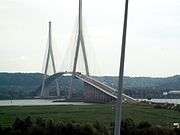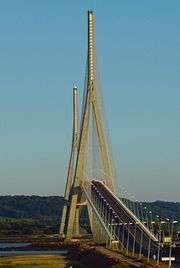Pont de Normandie
| Pont de Normandie | |
|---|---|
 Pont de Normandie | |
| Coordinates | 49°26′09″N 0°16′28″E / 49.43583°N 0.27444°ECoordinates: 49°26′09″N 0°16′28″E / 49.43583°N 0.27444°E |
| Carries | A29 autoroute |
| Crosses | Seine |
| Locale | Le Havre–Honfleur, France |
| Maintained by | Société des Autoroutes de Paris Normandie |
| Characteristics | |
| Design |
Cable-stayed bridge M. Virlogeux, F. Doyelle, C. Lavigne |
| Total length | 2,143.21 metres (7,032 ft) |
| Width | 23.60 metres (77 ft) |
| Height | 214.77 metres (705 ft) |
| Longest span | 856 metres (2,808 ft) |
| Clearance above | 52.00 metres (171 ft) |
| History | |
| Constructed by |
Bouygues Campenon Bernard Dumez Monberg & Thorsen Quillery Sogea Spie Batignolles |
| Opened | 1995 |
The Pont de Normandie (English: Normandy Bridge) is a cable-stayed road bridge that spans the river Seine linking Le Havre to Honfleur in Normandy, northern France. Its total length is 2,143.21 metres (7,032 ft) – 856 metres (2,808 ft) between the two piers. It is also the last bridge to cross the Seine before it empties into the ocean. Despite being a motorway toll bridge, there is a footpath as well as a narrow cycle lane in each direction allowing pedestrians and cyclists to cross the bridge free of charge.[1]
Construction
The bridge was designed by Michel Virlogeux, the general studies have been led by Bernard Raspaud from Bouygues, and the works management was shared between G. Barlet and P. Jacquet. The architects were François Doyelle and Charles Lavigne.[2] Construction by Bouygues, Campenon Bernard, Dumez, Monberg & Thorsen, Quillery, Sogea and Spie Batignolles[2] began in 1988 and lasted 7 years. The bridge opened on 20 January 1995.
At that time it was both the longest cable-stayed bridge in the world, and also had a record distance between piers for a cable-stayed bridge. It was more than 250 metres (820 ft) longer between piers than the previous record. This record was lost in 1999 to the Tatara Bridge in Japan. Its record for length for a cable-stayed bridge was lost in 2004 to the 2883 meters of the Rio-Antirrio. At the end of construction, the total cost for the bridge, all ancillary structures and finance costs was $465 million and was financed by Natixis. The bridge on its own cost €233 million (US$250 million).[3][4]
The cable-stayed design was chosen because it was both cheaper and more resistant to high winds than a suspension bridge. Shortly after opening, the longest cables exhibited excessive vibrations, so several damping systems were quickly retrofitted.
Structure
The span, 23.6 metres (77 ft) wide, is divided into four lanes for traffic and two lanes for pedestrians. The pylons, made of concrete, are shaped as upside-down Ys. They weigh more than 20,000 tons and are 214.77 metres (705 ft) tall. More than 19,000 tons of steel and 184 Freyssinet cables were used.
Gallery
 Side of Pont de Normandie
Side of Pont de Normandie From above
From above From the freeway A29
From the freeway A29- View from Honfleur
 Bridge on the north side
Bridge on the north side
See also
References
- ↑ Current price list.
- 1 2 Normandy Bridge at Structurae. Retrieved 30 September 2006.
- ↑ {{citation = http://www.planete-tp.com/en/IMG/pdf/3_cle67bb35-5.pdf | title =The Normandy bridge: The bridge in figures | accessdate =10 August 2014 }}
- ↑ "Construction Facts - The Sourcebook of Statistics, Records and Resources" (PDF), Engineering News Record, McGraw Hill, vol. 251, Number 20a, November 2003, retrieved 9 August 2014
External links
- Website of Pont de Normandie and Pont de Tancarville (in French)
- Website of the company operating the bridge (in French)

| Wikimedia Commons has media related to Pont de Normandie. |